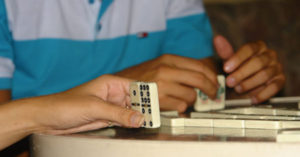The Dominó is a board game that used a few chips (tiles) rectangular, usually white face and black below, divided into two squares, each of which is marked from zero to a certain number of points (up to 6).
The written about domino oldest mention is documented in China, the “Ancient fact of Wulin” written (on the capital Hangzhou) written by Zhou Mi (1232-1298) during the Yuan dynasty, which referred to the “pupai” (plaques or dominoes games) and dice as items sold by merchants during the reign of Emperor Xiaozong of the Song (1162-1189).
The game usually is practice with four players alone. Mix the cards upside down and comprises 10 to each player, leaving on the table 40 (if 4 players are involved). Play against the clock hands. Each player attempts to join the number one end of one of your tabs with the number of a free end of any card that is face up on the table. If a player can do it, it misses the turn and continues the player on his right. Each player can play only a token per turn.
The first player to get rid of all the chips Announces: “I won” and wins the game.
Made very popular in all of Cuba, but in the region East is played in two so-called modalities: domino and capicua, consists of 28 cards, from 0 to 6. 7 cards per player are dealt.
La Inolvidable Doña Juana, la Dama del Dominó.
But move on to the unforgettable story of Doña Juana Martín de Martín who enjoyed a Cuban respectable family and social recognition, as she was the owner of the famous habanero garden Phoenix.
It had a hobby, liked to play, and always found an excuse to start a game of dominoes. That means that between flowers and dominoes, runned the life of Doña Juana.
The problem of Doña Juana was not time that engaged you in chips, but the altered that began when they were losing a data. 12 March 1925 the luck not accompanied her, as he could not recover from the adverse spate of recent days. But luck seemed to expect it just around the corner, or at least so it secured a cartomantica and others devoted to the art of the future.
Confident, Doña Juana Martín de Martín started his game that March 12 at the Galiano Street, number 43, where he lived. The game was developed favorably. I only needed to release the only tab that had. Two of the players they spent, it was her brother-in-law Pedro to play; the victory was almost certain and, just before proclaiming himself winner and confirm the designs of the adivinadora, Peter stretched out his hand and dominated. Joan couldn’t believe it, was left with the double three hands, and was so much outrage that happened it one after another, three strokes. Even with the tab strongly pressed between his hands he ceased to exist Doña Juana Martín.
She was buried on March 13, 1925 in the Necropolis Cristobal Colon. On top of its Pantheon goes with it the tab of the double three sculpted in white marble and black; and engraved on the tombstone, the game death won to Doña Juana can review.
Agencies/Wiki/Rad.Encyclopedia/Juan B. Rodriguez/Internet Photos / Arnoldo Varona / TheCubanHistory.com
THE CUBAN HISTORY, HOLLYWOOD.
EL JUEGO DEL DOMINÓ. LA INOLVIDABLE HISTORIA DE DOÑA JUANA.
El dominó es un juego de mesa en el que se emplean unas fichas (baldosas) rectangulares, generalmente blancas por la cara y negras por el envés, divididas en dos cuadrados, cada uno de los cuales lleva marcado de cero a un determinado número de puntos (hasta el 6).
La mención escrita más antigua sobre el dominó está documentada en China, en el escrito “Antiguos hechos de Wulin” (sobre la capital Hangzhou) escritos por Zhou Mi (1232–1298) durante la dinastía Yuan, donde se referían a los “pupai” (juegos de placas o dominós) y a los dados como objetos vendidos por los mercaderes durante el reinado del emperador Xiaozong de los Song (1162–1189).
El juego generalmente se práctica con cuatro jugadores en solitario. Se mezclan las fichas boca abajo y se reparten 10 a cada jugador, quedando en la mesa 40 (si participan 4 jugadores). Se juega en contra de las agujas del reloj. Cada jugador trata de unir el número de uno de los extremos de una de sus fichas con el número de un extremo libre de cualquier ficha que esté sobre la mesa boca arriba. Si un jugador no puede hacerlo, pierde el turno y continúa el jugador de su derecha. Cada jugador puede jugar solo una ficha por turno.
El primer jugador en deshacerse de todas las fichas anuncia: “Gané” y gana el juego.
Muy popularizado en toda Cuba, pero en la región oriental se juega en dos modalidades llamadas: dominó y capicúa, consta de 28 fichas, del 0 al 6. Se reparten 7 fichas por jugador.
LA INOLVIDABLE DOÑA JUANA, LA DAMA DEL DOMINÓ.
Pero pasemos a una historia inolvidable les hablaré de Doña Juana Martín de Martín la que gozaba de una respetable familia y del reconocimiento social, pues era la propietaria del famoso jardín habanero El Fénix.
Tenía una afición, le gustaba el juego, y siempre encontraba una excusa para iniciar una partida de dominó. Es decir que entre flores y fichas de dominó, transcurría la entretenida vida de Doña Juana.
El problema de Doña Juana no era el tiempo que le dedicaba a las fichas, sino lo alterada que se ponía cuando perdía una data. El 12 marzo de 1925 la suerte no la acompañaba, pues no lograba recuperarse de la racha adversa de los últimos días. Pero la suerte parecía esperarla a la vuelta de la esquina, o por lo menos así se lo aseguró una cartomántica y otros dedicados al arte de pronosticar el futuro.
Confiada, Doña Juana Martín de Martín inició su juego aquel 12 de marzo en la calle Galiano número 43, donde vivía. La partida se desarrollaba favorablemente. Solo necesitaba soltar la única ficha que le quedaba. Dos de los jugadores se pasaron, quedaba su cuñado Pedro por jugar; la victoria era casi segura y, justo antes de proclamarse ganadora y confirmar los designios de la adivinadora, Pedro extendió su mano y dominó. Juana no lo podía creer, se había quedado con el doble tres en las manos, y fue tanta su indignación que le sobrevinieron uno detrás de otro, tres infartos. Aún con la ficha fuertemente apretada entre sus manos dejó de existir Doña Juana Martín.
Fue inhumada el 13 de marzo de 1925 en la Necrópolis Cristóbal Colón. Encima de su panteón la acompaña la ficha del doble tres esculpida en mármol blanco y negro; y gravada, en la lápida, se puede repasar la partida que la muerte le ganó a Doña Juana.
Agencies/Wiki/ Rad.Encyclopedia/Juan B. Rodríguez/Internet Photos/ Arnoldo Varona/ TheCubanHistory.com
THE CUBAN HISTORY, HOLLYWOOD.









